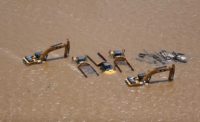Kelly J. Kinzer, an executive vice president in Willis Towers Watson’s Minneapolis office, was recently named the company’s North American construction specialties broking leader. Kinzer spoke to ENR Correspondent Scott Van Voorhis about builders’ risk coverage after last year’s hurricanes, where deductibles are up or down and how coverage is even available for contract liability penalties.
ENR What's the overall state of the builder's risk market?
Kinzer From a 50,000-foot level, the builders’ risk market remains very stable now, despite a really active season in 2017 with Harvey, Irma and Maria and the devastating wild fires in California. Domestic insurers continue to do very well and are growing their own capacity. At the same time, we have seen a steady supply of new players open up their doors in North America.
Where are premiums headed?
With the exception of wood frame, all that capacity has resulted in reduced rates across the board as well as broader terms and conditions. Conditions in wood framing have hardened considerably due to very poor loss experience. There have really been a lot of very costly fires. Some have been a direct result of vandalism and arson. We have a number of wood-framed insurers that have pulled out of the market and others that are reducing their coverage. There has been a 30 to 50% premium increase and security requirements are more stringent for the jobsites.
Was there a significant impact on premiums from hurricanes Harvey, Maria and Irma last year?
We did experience some quick, and I would call it minor, firming post Harvey, Irma and Maria. For tier-one projects, the markets swung very quickly back to pre-hurricane terms around the first of the year. Some of the deductibles were up. We had previously achieved a 3% named storm deductible. That went up to 5% for “critically exposed” projects in Florida in Miami and Dade and Broward counties. It has come down since then.
Why does water damage continue to be a leading cause of loss? What kind of firming are you seeing in the water damage deductible requirements?
The trend to water damage as a leading cause of loss is separate from what happened last year. Over the past 15 years, outside of natural catastrophes, water damage has been the leading cause of loss. Many of these losses are due to subcontractor and contractor negligence. Many are preventable. The severity has really increased over the past five years. As projects have gotten larger and more complex, the water damage claims have become more costly. In many markets, there are deductibles of $50,000, up from $25,000. It’s definitely a hot issue. In the past, the average water damage claim was $250,000. Now it’s not uncommon these days to see water damage claims that exceed a million dollars.
In what ways are carriers providing broader coverage?
We are seeing terms and conditions that were really only seen in the London marketplace, published by the London Engineering Group (LEG), now being offered in boilerplate fashion in North America. Domestic insurers now have the ability to provide coverage on a LEG 3 equivalent basis. Most builder’s risk coverage typically provides coverage on a LEG 2 equivalent basis. This excludes coverage for faulty workmanship and materials and then provides it back for damages. Under coverage provided by LEG 3, there is coverage for a defective part in addition to the damage.
Let’s say we have a high-rise office building and the windows are installed incorrectly and heavy rains are coming and damage the windows. The windows are excluded under LEG 2. Under LEG 3, we would have coverage for both the windows and the damage. Just a few years ago only a small number of carriers were providing this, with exorbitant deductions of $250,000 to $500,000. Now it's $100,000 to $250,000.
Why are new policy forms automatically including sub-limited coverage offerings for fungus, contract penalty, crane re-erection expenses, reward coverage, cyber risk, and pollutant cleanup and removal? What is driving demand for some of these new coverages and what is the pricing?
The carriers are truly looking for ways to differentiate themselves from their peers. The carriers are proactively looking for ways to define and deliver their respective value propositions. The result has been these types of coverages are much more readily accessible. In the past, fungus removal and pollution remediation needed to be requested and underwritten by the insurer. AIG, Chubb, Liberty Mutual and Zurich have started to embed these more unique policy extensions. And many of these carriers have become much more amenable to providing coverage for a sublimit of contract liability penalties, but it doesn’t equal pure liquidated damages coverage. A covered loss still needs to occur.






Post a comment to this article
Report Abusive Comment